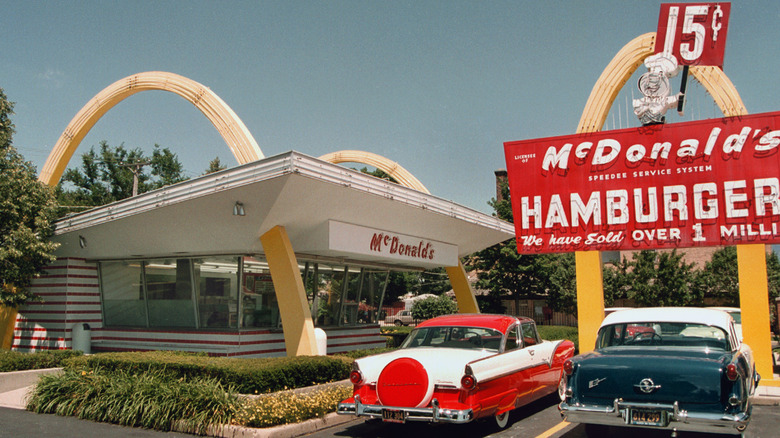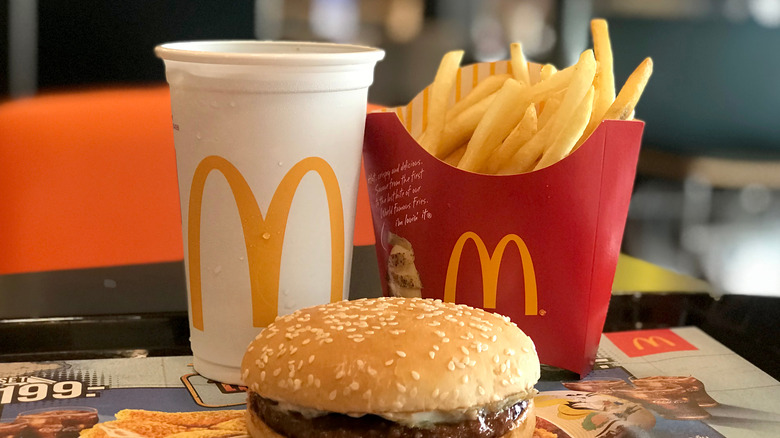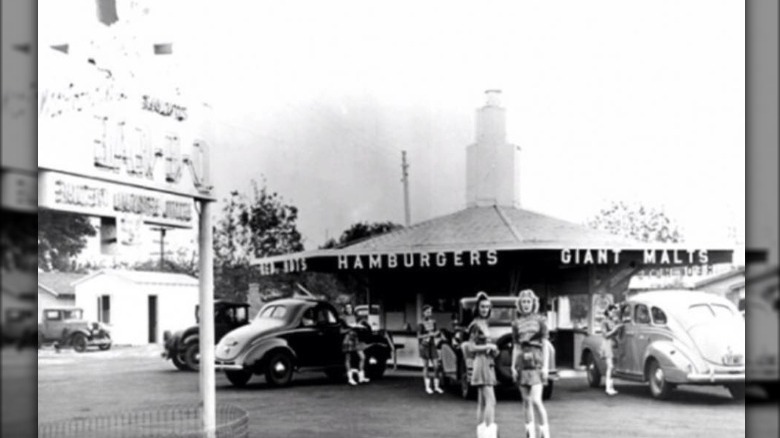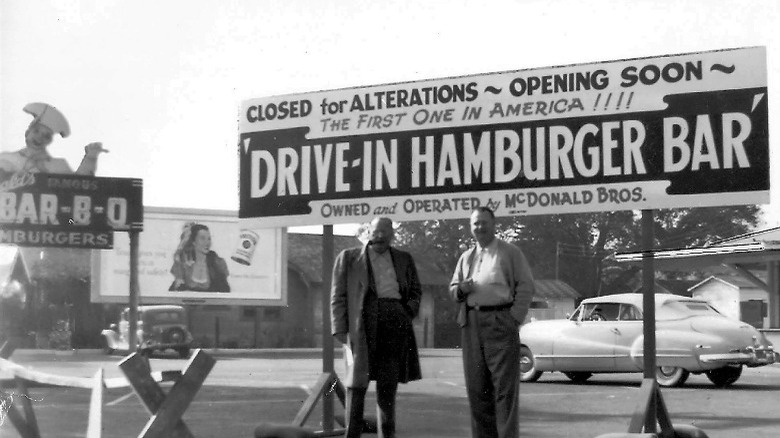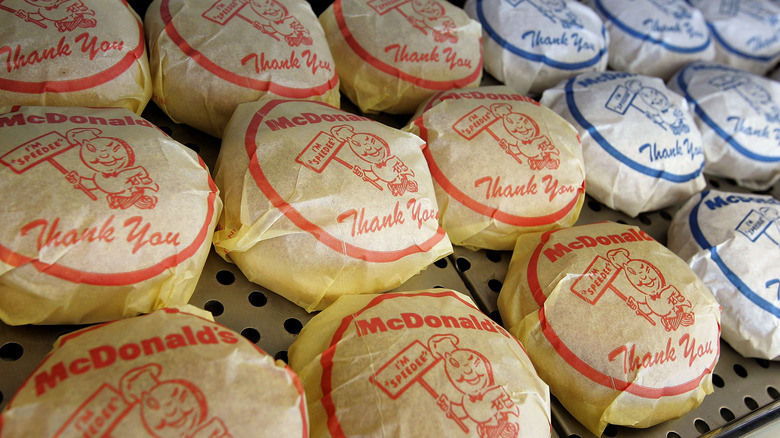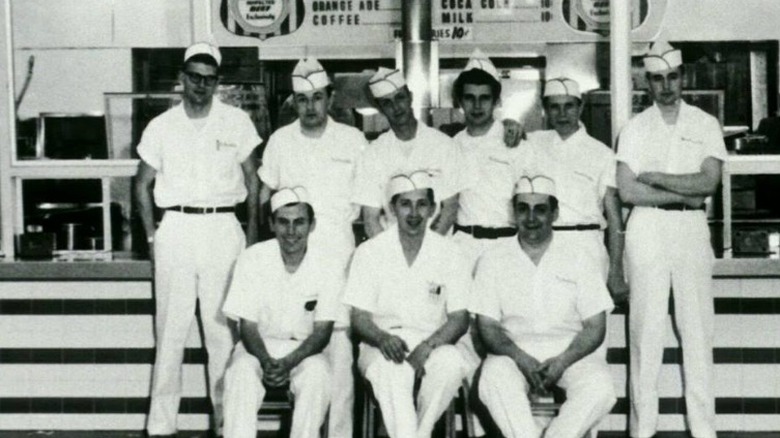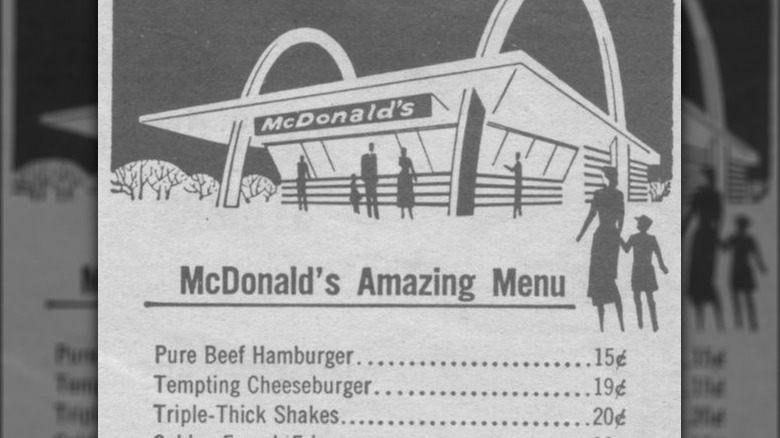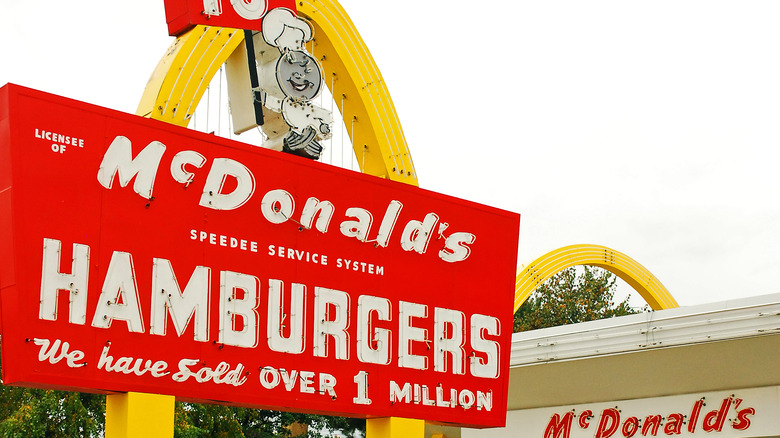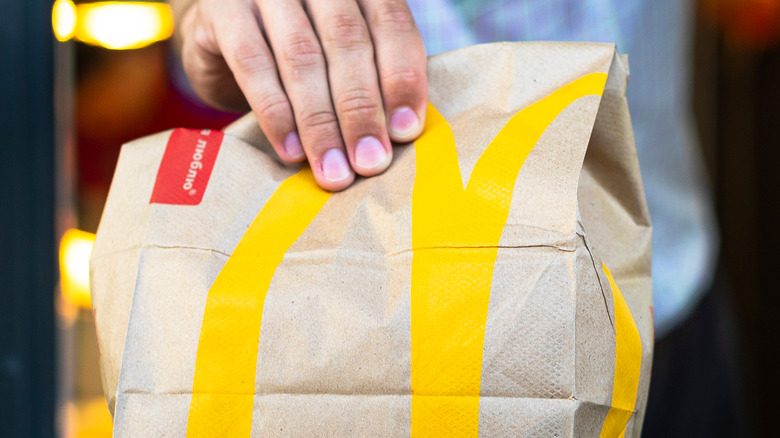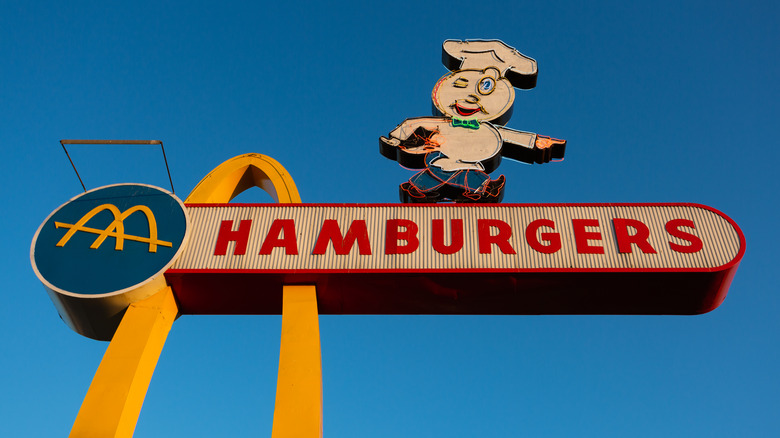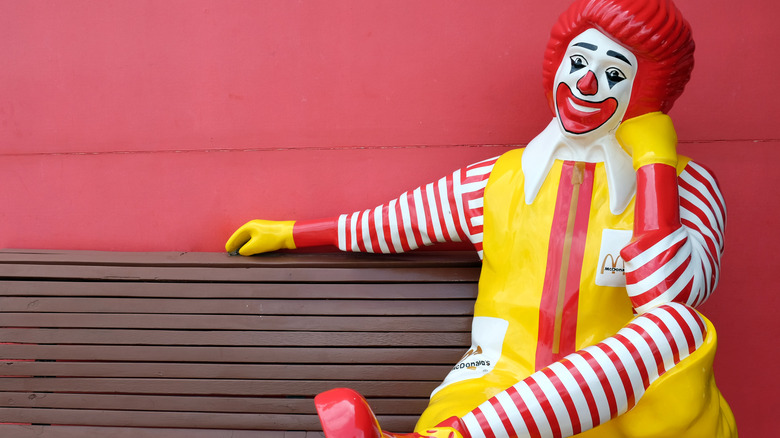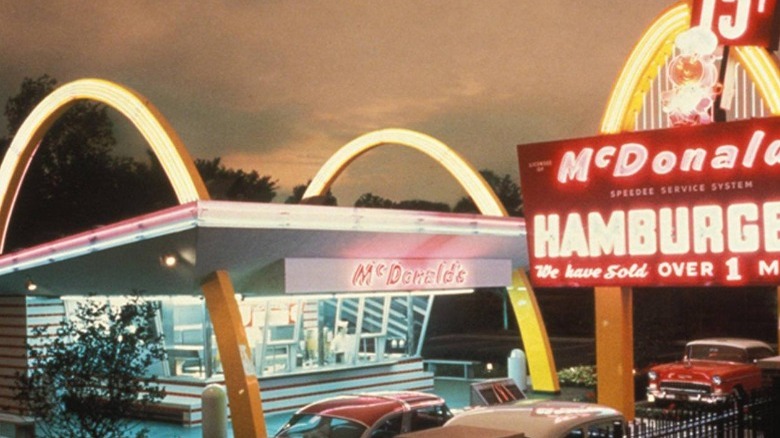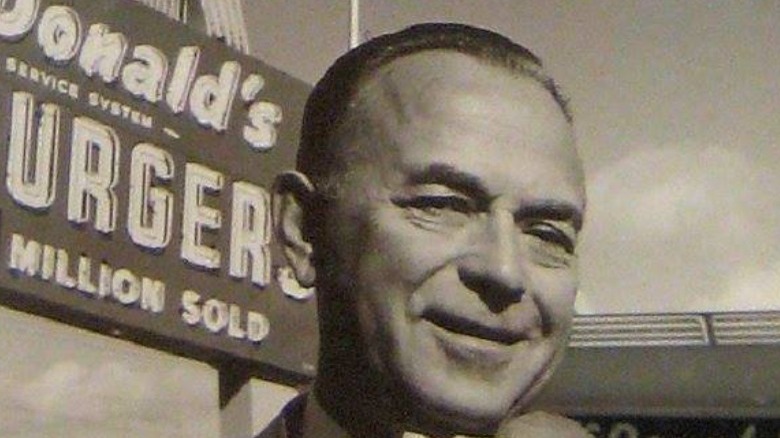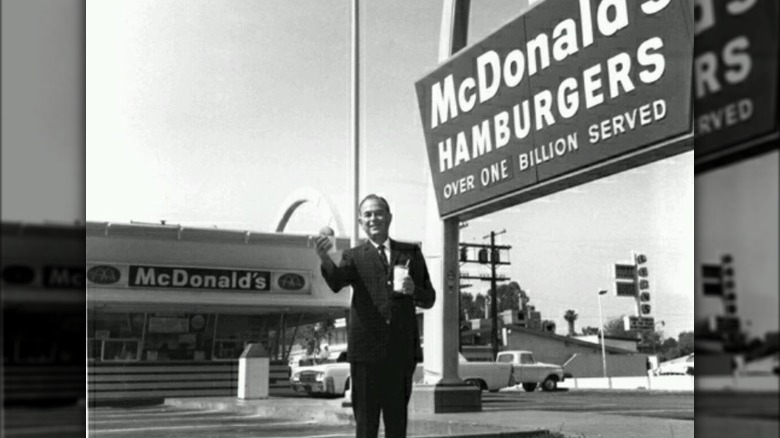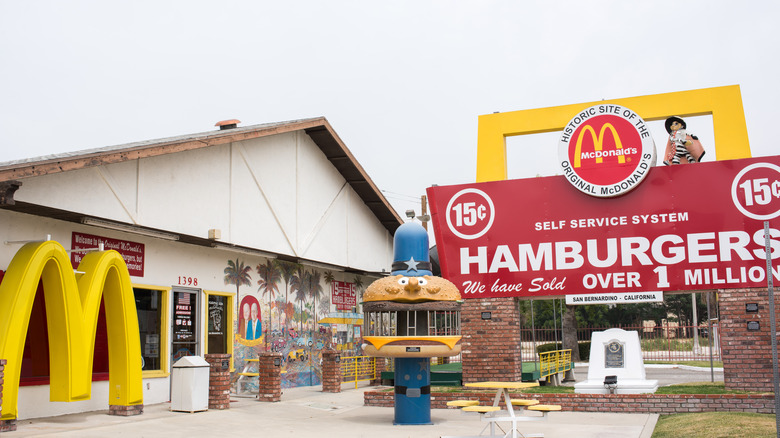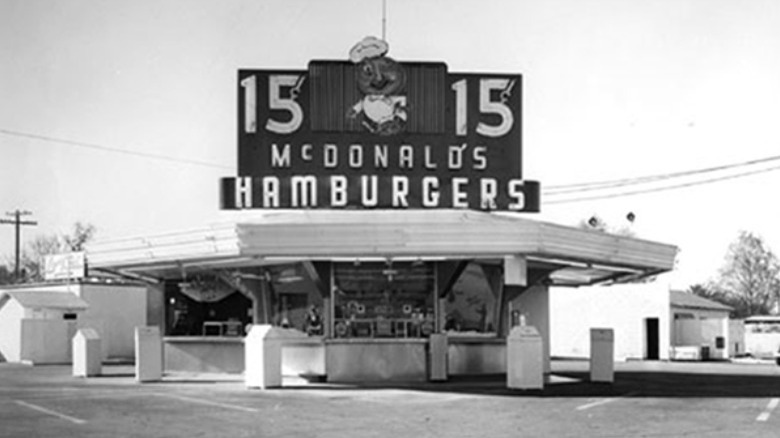The Secret History Of The First McDonald's
When it comes to ideas that changed the landscape of American eating, few have been as impactful as the idea for McDonald's. The chain restaurant is an international powerhouse. The corporate offices quote McDonald's at having topped 38,000 locations around the world, with over 210,000 employees and 69 million meals served every day. In some people's perspective, the famed Golden Arches of McDonald's and their mascot Ronald McDonald are "bigger than Jesus." No matter who holds more sway these days, Jesus and McDonald's have something in common: Both come from humble origins — although the history of McDonald's may be the more secret and less straightforward of the two.
The first McDonald's was founded by two brothers, Maurice (Mac) and Richard (Dick) McDonald in the mid-1940s. The siblings established their business in southern California, though history shows it wouldn't stay there for long. Over the years, the family-named stand went through several different phases before evolving into an operation that would be copied worldwide. Before that could happen, the McDonalds would need to join up with a slick salesman from Chicago (and invent the first scalable fast food business model. Then, their claim to the "original McDonald's" would be challenged. How did they do it all, and what became of their first burger shop? This is the history of the first McDonald's.
The first McDonald's food was cooked in a movie theater
Long before the concept for America's most iconic restaurant chain was cooked up, Mac and Richard McDonald were working on the first of countless burgers that would eventually be grilled in their name. As journalist Lisa Napoli details in her book, "Ray & Joan: The Man Who Made the McDonald's Fortune and the Woman Who Gave It All Away," the brothers McDonald had not come to California to cook. They had arrived to be movie moguls. After years of excruciating labor as crew hands in the studios, Mac and Dick decided to try their luck at screening films instead of working on them. They bought a theater and named it the Beacon. It was at the Beacon where the brothers first experienced food service.
Operating a movie theater is a tough, lean business. So the McDonalds had to come up with a clever and simple way to save and make money. Step one? Keeping guests from bringing their own food into the movies and newsreel screenings. Napoli writes that the McDonalds installed a concession stand and began selling their own food. Eventually, the Great Depression caused the Beacon to shutter. The brothers would then leverage their snack bar skills to really enter the world of foodservice.
The first McDonald's was a hot dog business
After leaving their Beacon theater, the McDonald brothers became very hands-on with building their restaurant business from the ground up. Literally. The brothers moved from one town over to take up shop on California's famous Route 66, where they constructed an octagonal food stall dubbed the "Airdrome." Still a ways out from starting on their famous hamburgers, the open-air food stand provided a unique link to the first McDonald's. At the time of its opening, however, it was something different.
Even with the difficulties of running a movie theater during economic turndowns, Mac and Dick knew that people would always need to eat. Close to the Airdrome was a small airport that often attracted travelers looking for free entertainment. After watching airplane traffic, folks would arrive at the Airdrome to consume inexpensive hot dogs and refreshing orange drinks. As Lisa Napoli writes for The Smithsonian Magazine, the Airdrome was popular enough to inspire the brothers further towards the restaurant industry.
Hot dogs have played an amusing part in McDonald's history since the beginning. Their success with selling frankfurters would help fuel Mac and Dick's ambition to be restaurateurs. (Decades later, the McHot Dog would end up being one of the brand's biggest flops.) Additionally, the building where the McDonald brothers had success selling hot dogs would end up being the home of the very first McDonald's restaurant. Only once they were outside the hot dog business did the brothers find success selling beef.
The brother's Airdome restaurant became McDonald's Bar-B-Q
Having found success in selling food, the McDonald brothers decided to expand their business by moving yet again. The Smithsonian Magazine writes that Dick and Mac took their operation to a small California town called San Bernardino. Here, they reconstructed the shell of the Airdrome, which they had cut in half and moved across the state. The brothers hadn't done all this to continue selling hot dogs.
Upon moving the Airdrome to "San Berdoo," Maurice and Richard opened their very first namesake restaurant, known as McDonald's Bar-B-Q (or Bar-B-Que depending on where you look). Yes, the restaurant served actual barbecue dishes, and no, the McRib was not one of them. That sort of special has been decades in the making (per The Atlantic).
The Library of Congress details how the first McDonald's location was as busy as any current-day neighborhood Mac Shack on a weekend evening, sometimes serving up to 125 cars a night. World War II made things tight for the food counter, but eventually, it was stiff competition in the food business which disrupted the McDonalds' early success and sent them back to the drawing board.
The barbeque restaurant closed to make way for a burger operation
In the middle of experiencing success with McDonald's BBQ, brother's Dick and Mac did something that was at once both daring and dangerous. They closed the doors of their shop. They wanted to reevaluate how their business could be better. America was rebounding from the stark conditions of World War II, and eateries now dotted the California landscape. The McDonald brothers had a goal to distinguish their service from other restaurants and to play a big role in the economic boom.
The Smithsonian's history of McDonald's details how the move to close the Bar-B-Q operation transformed McDonald's restaurants forever– and also nearly ended the company before it was born.
McDonald's Bar-B-Q was shuttered for several months in 1948 as the brothers retreated and reimagined everything from their steps of service to their menu and decor. When the brothers reopened, they no longer claimed to be a barbeque restaurant. The walls gleamed in white and red tile while silver machines were used to cook rapid foods. McDonald's had become a full-fledged fast food stand.
McDonald's only hired men in the beginning
It's been recorded that the McDonalds' barbecue venture was an early adopter of drive-through food service. Before glowing plastic menu boards and sliding glass windows, drive-throughs operated differently. Diners would roll into the parking lot of a restaurant to be greeted by carhops who were ready to take and run food orders. In keeping with their trend of doing things against the traditional sense, Mac and Dick McDonald decided to nix this position from their staff for a few reasons.
Dick McDonald once told The Washington Post that cutting out the carhop was a crucial part of the first McDonald's business model. By having customers walk to the window for their food, McDonald's eliminated the need for an extra person on the payroll. There's a lot of evidence suggesting other intentions behind the move. During the 1950s and '60s era of food service, most carhops were women. Ray Kroc, the man who would join the McDonald brothers in business, said bluntly in an interview at the time, "we don't hire female help" and stressed that locations were chosen to appeal to families, rather than "transients."
The first McDonald's had a small menu
In addition to unjustly removing women from their workforce, the first McDonald's had other unique operational changes. In the book, "Ray and Joan," Lisa Napoli writes that when the first McDonald's was housed in the Airdrome as a barbecue restaurant, it featured a large 25-item menu. Then, the brothers reopened the shop as McDonald's Hamburgers. The food bill was as thin as their early days in the movie business with only nine offerings.
Dishes were removed in order to streamline cooking procedures and a carefully choreographed dance was developed to fill the time between diners and their food. The most profitable items were kept while anything that didn't work was taken out with the trash. In his interview with The Washington Post, Dick McDonald said that the first items were simple: Hamburgers were given the option of cheese, but there were otherwise no modifications — they would come plain or with the standard ketchup, mustard, onion, and pickles. McDonald's also sold specially air-dried french fries, piping hot coffee, and the milkshakes that would inevitably lead them into the sights of business shark Ray Kroc.
Before Mr. Kroc appeared on the scene, there was almost nothing to see. The small size of the first McDonald's menu failed to attract customers, Napoli writes for the Smithsonian. There might not be kids smoking cigarettes, playing the jukebox, or flirting with carhops anymore, but there weren't any customers either.
The re-imagined McDonald's restaurant almost failed
Dick and Mac McDonald staked the future of the first McDonald's on a revamped experience that served the customers and the business. It would eventually change the food landscape of America, but in the '50s, it wasn't yet understood. Dick McDonald talks about how new customers would fill the parking lot with honking car horns when no one came out to greet their cars.
As Lisa Napoli tells it, those who remembered the barbecue joint returned to something different, old favorites now replaced by sparkling surfaces, neatly dressed men (and burgers), plus a kitchen that operated like a machine.
For the first time since the Depression-era days of the theater, McDonald's Hamburgers looked like it might never hit stride. On 14th Street in San Bernardino, the crew of the first McDonald's worked on without much of a crowd to feed. Lisa Napoli writes that the drought lasted four months. Even staged crowds couldn't generate interest. That is until one day when they did. In conversation with the Post, Richard McDonald chalks it up to the combination of a local radio host chattering about McDonald's on-air, and the cheap 15-cent burgers. Maybe it was divine intervention. Whatever it was, eaters started to show up.
The McDonald brothers began using the first location to sell their model
After a slow start, the first McDonald's became a hot spot on southern California's food map. So hot that the shape of a thermometer was painted outside the building. When the temperature reached "One Million Burgers Sold," the thermometer shattered and Mickey D's reached a fever pitch (per Lisa Napoli).
"All hell broke loose," Dick McDonald told The Post. The brothers were fielding calls for help from restaurateurs all over the country. Entrepreneurs wanted what the McDonald's was selling, but they weren't telephoning about the food. McDonald's lightning-quick cooking times, streamlined service, and low-cost business model were totally new to the industry. Other operators needed to know how it worked. The first McDonald's building became a business independent of the food.
The Smithsonian Magazine details how the initial McDonald's structure was opened for demonstration to curious and potential business owners interested in learning the model. From the kitchen and lobby of that first octagonal building, the idea for a McDonald's franchise was born.
The McDonald brothers began licensing their special quick-service system at a price of $950. They sold instruction manuals. An interested purveyor from Phoenix named Neil Fox appeared, but he came for more than the milkshake recipe and an operating method. In 1953, Fox took on the McDonald's name for "good luck" in his own restaurant. It was the first McDonald's franchise location outside of the original and was even the first to feature the signature golden arches.
McDonald's Speedee Service System provided the foundation for fast food service
As History puts it, what made the original McDonald's such a profitable enterprise was the signature operation plans that Dick and Mac had begun selling across the country. It was known as the Speedee Service System. The System included guidance on how to maximize efficiency in that new McDonald's way. It became the bible of a fast food revolution.
The Speedee System was like Henry Ford's automated car line, but with food. The inside of McDonald's became a uniquely mechanized establishment for its day. In The Smithsonian, Lisa Napoli writes that the brother's modeled their easy-made menu from a New England builder called Levitt. Next, they installed their McDonald's with custom inventions like an automated condiment dispenser and Multimixer machines that could pulse milkshakes faster than the competition. They mapped the movements of the kitchen workers out with chalk. It was a totally new way of running a restaurant.
In an article for the BBC, Tim Harford detailed how the Speedee Service System reinvented the game by revealing the inefficiency of quick-service restaurants at the time (carhops included). Restaurant owners had proof that a short wait for hot food was what customers really craved. Napoli writes in the Smithsonian that a 1950s expansion of American car culture moved the needle even closer to fast foods. The Speedee System helped the first McDonald's franchises crawl out from California and the fast food model zipped along with them.
There was a mascot before Ronald
These days, Ronald McDonald is one of the most well-known mascots in the world (despite having faded away for the most part). From charity houses over the ocean to the Macy's Day Parade, the red and white clown was the face of the burger company for decades. Once imagined, Ronald would emerge as the marketing vehicle for one of America's biggest businesses during years of expansion. There was another mascot that had to walk before Ronald could run.
The first McDonald's was represented by an entirely different face, and this mascot wasn't there to advertise family-friendly fun. It was there to sell speed. Prior to a yellow-suited clown, McDonald's featured a pudgy-faced mascot named Speedee. Speedee was a chef with a round face that adorned billboards, signs, and even the McDonald brother's operation manual. During the early years at that first restaurant, Speedee played a big part in characterizing the McDonald's model for potential customers and licensees.
Speedee was retired from McDonald's in 1962, a few years after McDonald's franchises began to appear (per Mental Floss). Surprisingly, Ronald wasn't the first to replace Speedee. It was actually the famed Golden Arches.
The Golden Arches were designed to be a roadside billboard
When Neil Fox showed up in San Bernardino California for a meeting with the McDonald's brothers, he intended to come away with a new restaurant concept. He likely never intended to help build a logo that would become more recognizable than the cross.
Johnathan Glancey details for the BBC that the history of the McDonald's Arches developed something like this: Fox purchased the rights to build the first franchise location of McDonald's from Richard and Maurice. The brothers wanted to be involved in designing the restaurant, and so together with architect Stanley Clark Metson, they came up with an idea to feature two golden arches on either side of the white-tiled structure. Per Business Insider, their goal was to create a functional building that would act as its own roadside billboard, signaling hot food to hungry and weary travelers.
As the McDonald brothers carried on in their remodeled version of the Airdrome, the franchise location in Phoenix got the honor of building with a brand new design. It may not have been the original McDonald's, but the truth is that this franchise location owns the claim of being the first-ever building to display the signature Golden Arches in McDonald's name.
The first CEO sold milkshake machines to the original McDonald's
Among the nine menu items first served at the original McDonald's, there is one item in particular that played a historic role in the growth of the company. In "Ray and Joan," Lisa Napoli writes that during the 1950s, Chicagoan Ray Kroc worked as a traveling salesman slinging milkshake machines. After receiving notice of an operation needing a large quantity of his 5-cup Multimixers, Kroc hopped in his car and took a drive (per Time Magazine). It didn't take long for Kroc to see why the first McDonald's needed so many blenders. What he found on his sales call changed the trajectory of the first McDonald's.
At the time, the Mac Shack was just beginning to gain steam (though that famous sandwich was years from development). Kroc delivered on the McDonald's brother's large order of milkshake machines, says Napoli, but it wouldn't be his final interaction with the McDonald brothers. Seeing the growth potential, Kroc's next sale to the restaurant would be himself: As the franchise agent, Ray Kroc promised to help McDonald's grow in scale (per Biography.com). He started his own location which was to be the first of many more.
Inevitably, Kroc would be the person known for taking McDonald's past its humble, octagon-shaped walls and into the international market, despite not being around with the restaurant during its earliest days.
Ray Kroc opened the second, "First McDonalds"
According to Time Magazine, shortly after joining the McDonald brothers in business, Ray Kroc proceeded to try and wrestle control away from them. Mac and Dick had taken a big chance in remodeling McDonald's from a barbecue joint to a hamburger stand. Even with their success at the time, the Daily Mail reports that the two founders were not as interested in rapidly expanding the business as compared to Kroc, who had the vision for a McDonald's on every corner long before it was reality. In order to work his way towards acquiring and growing the company, Kroc opened up his own franchise location in Des Plaines, Illinois. It was the second, "First McDonald's."
McDonald's Corporate writes that as Kroc opened his franchise store, he started an entirely fresh company within its walls. The Des Plaines, Illinois location was the first McDonald's in a (technically) brand new business venture. Kroc registered his company as McDonald's Systems Inc., later known as the McDonald's Corporation. It was entirely independent of his licensing agreement with the McDonald brothers.
While Mac and Richard carried on in San Bernardino at their original store, Kroc took their name and logo wherever he could. To the chagrin of Richard McDonald, Kroc called himself the Founder and named Des Plaines as the birthplace of the idea for his chain concept. According to Kroc, his restaurant is the real first McDonald's.
The original McDonald's is still there as a museum
Today, American diners can read about the history of McDonald's and make their own choice about which spot deserves the right to be called the first. Is the restaurant we know today a direct descendent of the San Berdoo stand, or just an idea inspired by it? The debate can take you two different ways, but only one location is still around to be explored. As to which one it is, well, that might tell you who gets the final say of being the "original."
Reporting by The Chicago Tribune classifies the Des Plaines, Illinois outlet as being McDonald's #1. In 1982, the building was torn down and then rebuilt with the original sign out front. It then became a museum replica that depicted the beginnings of the Mickey D's operation. For decades, this location served as a mecca to McDonald's fans until it was closed in 2008 and then demolished in 2017.
As for the "original" original, history lives on. Now, visitors have access to an unofficial McDonald's museum housed in the old bones of this California location. Operated by a local fast food purveyor named Albert Okura, the collection is private and has no formal affiliation with the Kroc-constructed corporation (per ABC News). Still, tourists can come to see piles of McDonald's history that have been crowdsourced over 80 years of business.
The real first McDonald's was a source of pain for Kroc
After purchasing the naming rights for his company in the 1960s, Ray Kroc attempted to run the McDonald brothers out of business. According to Daily Mail, it wasn't enough for Kroc that the two had to re-title their restaurant as they watched their last name become an international powerhouse despite them. No. In the spirit of making McDonald's as big as it could be, Kroc was determined to erase the humble history of Maurice and Richard McDonald and name himself the Founder.
When Kroc went to buy out the McDonald brothers, the agreement came with a condition, writes Daily Mail. The original location would not be included in the transfer of franchises. Dick and Mac got to keep their store and Ray Kroc was free to build as many more as he liked. Despite the two founders changing the restaurant's name to "The Big M," Kroc was infuriated and vowed to get revenge. He opened a McDonald's location just blocks away. Several years later, the McDonald's brothers shut off their grills for the last time. However, as Lisa Napoli told Marketplace, it wasn't all bad: "The brothers had wanted to give over the restaurant to their employees and they did."
The story of Ray Kroc's corporation may live on in our bellies but the persistence of Maurice and Richard McDonald will live on in our hearts.
